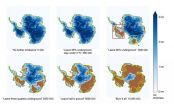Study: No sex differences in research funding at Johns Hopkins Department of Medicine
Women, men medical researchers receive National Institutes of Health grants at similar rates
2015-09-12
(Press-News.org) Though national data suggest that women researchers are less likely to obtain independent research funding than men, a study published in the Journal of Women's Health found that male and female researchers at the Johns Hopkins University School of Medicine are funded at nearly the same rate.
Rita Rastogi Kalyani, M.D., M.H.S.; Hsin-Chieh Yeh, Ph.D.; Jeanne Clarke, M.D., M.P.H.; Myron Weisfeldt, M.D.; Terry Choi; and Susan McDonald, M.D., all of Johns Hopkins, authored the study.
Kalyani points out that, in recent years, Johns Hopkins has demonstrated a commitment to diversity and fostered a collegial and encouraging research environment.
"The Department of Medicine has had several long-standing efforts to promote diversity and research success at Johns Hopkins," says Kalyani, an assistant professor of medicine in the Division of Endocrinology, Diabetes and Metabolism. "Diversity in the workplace has been integrated as a priority."
Young scientists and clinicians who are awarded early-career development grants, or K grants, by the National Institutes of Health (NIH) are expected to advance eventually and establish independent research careers. The next step toward that independent career is an NIH research project grant, known as an R01 grant.
The authors compared K grant awardees at Johns Hopkins against national trends.
A 2009 study published in the Annals of Internal Medicine found that, nationwide, women were 21 percent less likely to receive independent research grants than men.
Between 1999 and 2008, 92 faculty members in the Department of Medicine at Johns Hopkins received K grants -- 49 men and 43 women. Of those grantees, 34 would eventually receive R01 grants -- 16 men and 18 women.
"In comparison to national data that report sex differences in attainment of independent funding, we found no sex differences among K award recipients in the Department of Medicine at Johns Hopkins," Kalyani says.
Women represented roughly one-third of the active physician workforce in the United States in 2013. Though that number has increased over time, women remain a minority in academic medicine. According to the American Association of Medical Colleges, in 2013-2014, women constituted 38 percent of full-time medical school faculty, but only 21 percent of full professors, 15 percent of department chairs and 16 percent of deans.
The authors point out that, while there remain significant barriers to research success for women, their study's results are encouraging. They add that further studies are needed to investigate the impact of specific diversity initiatives on research success at other institutions.
INFORMATION:
ELSE PRESS RELEASES FROM THIS DATE:
2015-09-11
WASHINGTON (Sept. 11, 2015) -- The largest nationwide clinical trial to study high-dose resveratrol long-term in people with mild to moderate Alzheimer's disease found that a biomarker that declines when the disease progresses was stabilized in people who took the purified form of resveratrol.
Resveratrol is a naturally occurring compound found in foods such as red grapes, raspberries, dark chocolate and some red wines.
The results, published online today in Neurology, "are very interesting," says the study's principal investigator, R. Scott Turner, MD, PhD, director ...
2015-09-11
CORAL GABLES, Fla. (September 11, 2015) -- Researchers from the University of Miami and Harvard University address the challenges of effective universal health coverage in low- and middle-income countries, focusing on solving one of the most pressing issues: the care of chronic illnesses. Their suggestions, aimed at strengthening health care systems, include recommendations based on a "diagonal approach" for managing health care. Their report is published in the September issue of the journal Health Affairs.
The authors shared their findings on Wednesday, September 9, ...
2015-09-11
Washington, DC--New work from an international team including Carnegie's Ken Caldeira demonstrates that the planet's remaining fossil fuel resources would be sufficient to melt nearly all of Antarctica if burned, leading to a 50- or 60-meter (160 to 200 foot) rise in sea level. Because so many major cities are at or near sea level, this would put many highly populated areas where more than a billion people live under water, including New York City and Washington, DC. It is published in Science Advances.
"Our findings show that if we do not want to melt Antarctica, we ...
2015-09-11
Burning all of the world's available fossil-fuel resources would result in the complete melting of the Antarctic ice sheet, a new study to be published in Science Advances shows. The Antarctic ice masses store water equivalent to more than 50 meters of sea-level rise. The new calculations show that Antarctica's long-term contribution to sea-level rise could likely be restricted to a few meters that could still be manageable, if global warming did not exceed 2 degrees. Crossing this threshold, however, would in the long run destabilize both West and East Antarctica - causing ...
2015-09-11
A study conducted by biologists at UC San Diego has found that the Africanized honey bee--an aggressive hybrid of the European honey bee--is continuing to expand its range northward since its introduction into Southern California in 1994.
The study, published in this week's edition of the journal PLOS ONE, found that more than 60 percent of the foraging honey bees in San Diego County are Africanized and that Africanized bees can now be found as far north as California's delta region.
"Our study shows that the large majority of bees one encounters in San Diego County are ...
2015-09-11
Scientists have identified an ingeniously elegant brain circuit consisting of just five nerve cells that allows female crickets to automatically identify the chirps of males from the same species through the rhythmic pulses hidden within the mating call.
The circuit uses a time delay mechanism to match the gaps between pulses in a species-specific chirp - gaps of just few milliseconds. The circuit delays a pulse by the exact between-pulse gap, so that, if it coincides with the next pulse coming in, the same species signal is confirmed.
It's one of the first times ...
2015-09-11
Researchers from Lund University in Sweden have shown that well-developed eyes come at a surprising cost to other organ systems. The study involving Mexican cavefish shows that the visual system can require between 5% and 15% of an animal's total energy budget.
Researchers have long associated the presence of a well-developed brain with major energy consumption. This means that animals that develop advanced nervous systems require environments where this is possible. There has to be good access to nutrients, and every investment in an organ comes at a cost to some other ...
2015-09-11
WASHINGTON (Sept. 11, 2015) - A statement from American College of Cardiology President Kim Allan Williams Sr., M.D., FACC, regarding the National Institutes of Health stopping the SPRINT trial early after demonstrating the positive benefits of lower blood pressure control targets:
"About 70 million American adults have high blood pressure and only half of them have their condition under control. The preliminary data demonstrates why the cardiovascular community must continue to aggressively fight a condition that leads to stroke, kidney disease and heart problems for ...
2015-09-11
Washington, DC - September 11, 2015 - Periodontitis is a risk factor for heart disease. Now a team of researchers has shown that a periodontal pathogen causes changes in gene expression that boost inflammation and atherosclerosis in aortic smooth muscle cells. The research is published ahead of print in Infection and Immunity, a journal of the American Society for Microbiology.
The circumstantial evidence that led to this study was ample. The periodontal pathogen, Porphyromonas gingivalis, has also been found in coronary artery plaques of heart attack patients. And in ...
2015-09-11
This election year has produced 17 Republican presidential candidates, which on its surface may appear to give the party a competitive advantage. Evolution, however, disagrees.
A new study by Michigan State University researcher Arend Hintze and appearing in the current issue of Scientific Reports, says the delicate balance of some, but not too much, competition optimally drives the evolution of decision-making strategies.
"Competition has a unique relationship with our decision-making strategies as humans," said Hintze, an assistant professor at MSU. "Modest competition ...
LAST 30 PRESS RELEASES:
[Press-News.org] Study: No sex differences in research funding at Johns Hopkins Department of Medicine
Women, men medical researchers receive National Institutes of Health grants at similar rates

